Ideas for making bicycling irresistible in Washington DC
proposed additions to the DDOT DC Bicycle Master Plan (BMP), inspired by the Active Transportation initiative as conceptualized by the Rails to Trails Conservancy
First submitted: 4/17/2008
Modified a number of times subsequently, including incorporating comments provided by a handful of people, including Washcycle.
-------------
I’ve reviewed the DC and Arlington Bicycle Master Plans, a journal article by John Pucher, and a number of items from the Transport for London, SF Municipal Transportation Agency, the City of Seattle, and the City of Berkeley websites. I should have spent more time re-reading the DC BMP, and I am not intimately familiar with all of WABA’s programs, as well as various bicycling promotion programs by other organizations such as the Downtown DC BID.
Be that as it may, recommendations of things that could be added to the BMP/to a TEA proposal beyond the BMP are listed below, after this introductory section.
The basic philosophy is one of building the environment/urban space where walking, bicycling and transit are normal parts of your every day urban lifestyle, rather than something you do as a special weekend activity, or just to go to and from a specific destination.
Cycling user (market) segments. In my work in commercial district revitalization and planning retail mix, I have learned that it is important to more carefully dissect potential user segments. For bicycling, I think that the following factors are important, and it's not clear that this kind of finer-grained approach was employed in developing the BMP:
1. Origin of bicyclist: neighborhood resident; city resident; in-region resident; visitor from out-of-region;
2. Demographic: age; gender; household type (i.e., do multiple people need to be accommodated simultaneously);
3. Purpose of trip: commute to work; recreation-fitness; ride to school; ride to perform tasks, errands, work (bicycle messagers, pedicab drivers, tour guides);
4. Length of trip;
5. Destination;
6. Institution: school, college, business, government agency.
Origin. The BMP skews towards the consideration and accommodation of City residents. While any rider will benefit from improvements to the bicycling infrastructure system, needs and wants can vary considerably, depending on this factor. For example, a bicycle commuter may wish to have access to showers and lockers, while this isn't required for in-neighborhood bicycle trips. But accommodation of bicycle commuters originating outside of the city may be particularly important, in terms of being able to interdict SOV car trips to the city.
Demographics. The survey data collected in BMP process was skewed to regular riding males under 40 years of age. Needs of different segments were likely missed. (And the suggestions below do not reflect needs that may exist on the part of bicycle-based workers, such as messengers.)
BMP goals. The DC Bicycle Master Plan lists three goals:
1. More and Better Bicycle Facilities;
2. More Bicycle-Friendly Policies;
3. More Bicycle-related Education, Promotion, and Enforcement.
I would argue that the third goal should be broken up into separate goals; that education and encouragement (promotion) be considered a goal independent from Enforcement, and that more broadly enhanced communications should be listed as an additional goal. Furthermore the goal of “bicycle facilities” needs to be considered far more broadly than hard infrastructure.
As you will see from the various sections below, a number of opportunities are present that exist outside of the Bicycle Master Plan as currently approved. Adding these types of projects and ideas to the TEA grant proposal could significantly strengthen it, making it much more competitive. Furthermore, granting agencies tend to like proposals that are significant rather than rote, and by providing the means to communicate the results of the program (not discussed below) so that best practices can be disseminated and replicated elsewhere, that could help this proposal be even more competitive.
In terms of costing and financial engineering, areas in which I am no expert, I think it’s important to think elegantly and cost-effectively. E.g., according to the Berkeley Bicycle Boulevards website, they have spent $330,000 thus far implementing that program. That puts the opportunity to receive $60 million to enhance the bicycling environment in DC in perspective. It’s very exciting.
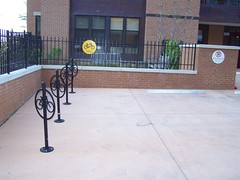
A parking space at the Friends National Service Committee office at 2nd and C Streets NE has been converted into a bicycle parking space able to accommodate 8 bicycles rather than one car.
Infrastructure
• Enhanced bicycle path network system. More defined hierarchy of routes. (Seattle, Berkeley) (For the most part the BMP covers this, with the exception of the next 2 points.)
• Creation of some physically separated bike routes (cycle tracks) within the street network along the lines of
• Enhanced route marking and signage system. (
• The current signage system could be augmented by including signs pointing to specific facilities and destinations adjacent to the route, including recreation centers, public schools, public libraries, and notable sites. For example, the
• Modify the blue DC wayfinding signs to better denote transit proximity and at the same time add information about supportive bicycling facilities.
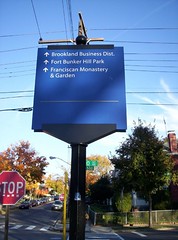

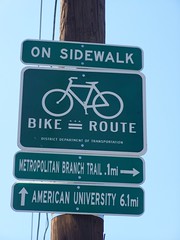
• Consider the creation of bike lifts for particularly steep hills. In
• Where demand is indicated through surveys, work with non-DC jurisdictions to enhance the ability to bicycle to and from DC (i.e.,
• Work with WMATA to make the transit system and stations more intermodal. (See next section below).
• Air compressors/bicycle pumps at bikesharing stations, to service all riders, at all WMATA stations, at certain DC Government buildings?
• Bicycle rack expansion and request program. (To determine need, Washcycle suggests doing a survey by identifying where bikes are parked to something else.)
• Make sure that parking meter changeover is accompanied by replacement bike racks.
• Make the bicycle racks more attractive. The DDOT racks are large and unelegant. Could have a program in association with DC Commission on the Arts and Humanities to develop “art” bike racks. But nicer options exist already. (WABA image below.)
•Trail planning and development for recreational purposes is a separate purpose with different needs than every day cycling, and should be treated so.
• Regarding tourism and recreation objectives, consider the creation of bicycling-oriented “scenic byways” through the city with appropriate signage programs.
• Could a system for supporting bicyclists in need be developed, comparable to the DDOT Roadway Operations Patrol system? What about working with AAA and other roadside assistance programs to support bicyclists in need? (Pilot project to be funded by the TEA grant.) (Communicate availability on all communications, including signs posted within the bike route signage system.)
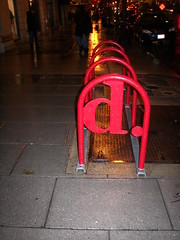
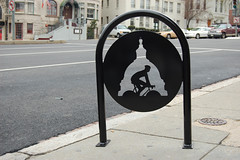
Washington Area Bicyclist Association bicycle rack (and photo).
Make WMATA more intermodal
• Appoint a bicycle and pedestrian coordinator for WMATA, charged with making the system more accommodating of bicyclists and pedestrians, especially with regard to joint development projects (real estate division).
• Make the transit system and stations more intermodal, recognizing the ability to take bicycles on buses is world class, and on the subway is quite good.
• Better bicycle accommodations, especially parking (
• Are there stations within the subway network (in DC and outside of DC) that are good locations to add bikestations? (Fund a pilot location within DC with the TEA grant.) (While discussed in the planning stages, a bike station is not being installed in the portion of the Silver Spring Transit center currently being constructed by WMATA and Montgomery County Dept. of Public Works and Transportation!!!!!!!)
• An initial step would be to have simple bicycle air pumps available in all station master offices at subway stations. Eventually, add air compressors to all WMATA stations.
•Bicycle hooks on trains?
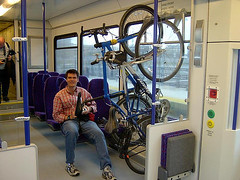
Bike racks on NJ Transit cars. Photo: Washcycle.
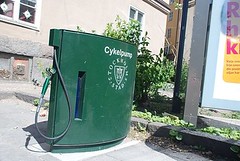
Flickr photo of Stockholm bike tire pump station from Let Ideas Compete. These air compressors are located in bicycle parking areas at subway stations and in other public places.
Make VRE and MARC more intermodal
• Neither MARC nor VRE allow nonfoldable bicycles to be brought aboard trains. Strategic placement of hooks on trains could accommodate bicycles on passenger cars.
• Survey stations around bicycling issues in terms of racks and other accommodations. Determine if there is potential for a bike station at any of the stations.

The Massachusetts Bay Transportation Authority unveiled a commuter rail coach fitted with 39 bicycle racks. Officials also toured the first coach completed in a $23.5 million program to refurbish air conditioning units and old windows in 162 commuter cars. (William Moore/Boston Globe Photo)
Ward/Neighborhood bicycling enhancement
• Rate all neighborhoods in terms of their capacity to support bicycling including topography, distance to amenities and other destinations, location of schools and parks, etc. (Could use DCOP’s 37 planning areas for the organizing framework for this activity.)
• Create (relatively simple) subplans of the Bicycle Master Plan for neighborhoods-ANCs-Wards and develop programs to enhance bicycling within neighborhoods based on this assessment. Create programs that are fine-tuned to local conditions, rather than one-size-fits-all programs that will fail if implemented in places with unfavorable conditions.
• Create focused programs to engage demographic segments under-represented in the ranks of bicyclists: children; families; disabled (
• Ensure that bicycling promotion programs provide information, focused outreach, and assistance to various ESL demographics.
• DDOT and DCOP have ward planners. (And DPR has Ward coordinators for
• Develop stronger civic engagement/volunteer programs. Non-government employee bicyclists can serve as “ambassadors,” mentors, and “buddies” to move people along the path from occasional rider to daily bicyclist.
• Community-neighborhood cycling enhancement grants (
• Annual neighborhood and/or ward rides, comparable to BikeArlington and
• Create neighborhood bicycle tours with online and printed maps. Partner with DestinationDC and CulturalTourismDC to do this.
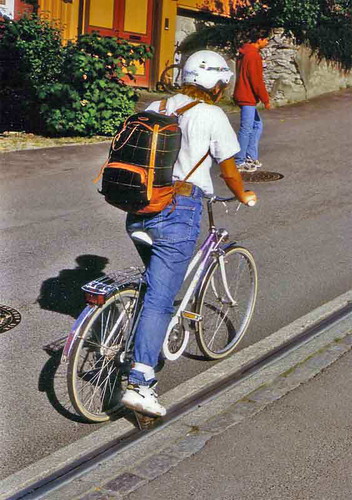
Bicycle Lift, Trondheim, Norway. Photo: Fresh99.
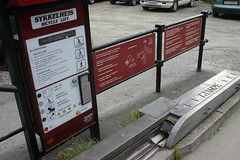
Flickr photo by neofob.
Large campuses and Business Improvement Districts as proto-transportation management districts and helping to meet the needs of bicyclists and promoting mode shift
• DC doesn’t have a solid Transportation Demand Management (TDM) planning and service structure in place, and there are not officially sanctioned Transportation Management Districts (TMDs) unlike in
• Large campuses such as colleges/universities and the
• Create Bicycle and Pedestrian/TDM planner positions for BIDs, funded similarly, as suggested above with the idea of creating Ward Bicycle and Pedestrian Transportation Planners. Larger BIDs (Downtown, Golden Triangle) could have full-time positions. Smaller BIDs could share B&P/TDM planners. (Also see Arlington Transportation Partners as an example. These Ward and Commercial District bicycle-pedestrian-TDM planners would be supported by a strong TDM program and infrastructure agency within DDOT.)
• Payroll deduction programs to assist workers in buying bicycles. DC Government should do this now.
• Encourage organizations to develop bike fleets to support workday trips for non-bicycle commuters. Alternatively, create schemes for institutions to be able to provide this service by participating as an organizational member within the bikesharing system (below). This can also be done at the building level, as a service offered to building tenants by the building owner. Since a number of property owners own multiple properties, it would be possible to do this with economies of scale.
• Assist colleges in developing programs to provide bicycles to students (
•There should be a bikestation equivalent present within all major commuting districts located within the city. Perhaps shared facilities rather than facilities in every building.
• Could the
• Could bikestation/bikestation-like facilities be developed into a system, where membership in one bikestation-bicyclist service program provides occasional guest privileges at other locations?
• Workplace-campus-based TDM/mode shift programs, particularly bicycling. Mayo Clinic has a program to assist potential bicyclists by lending bicycles to employees for use-experimentation-comfortability for up to three weeks, so that people can try out bicycling without having to first buy a bicycle.
•Work with hotels to provide rental bikes for guests. (Hotel guests would likely want lighter bikes and longer rental periods than what will be made available via the SmartBikeDC program.)
• Work with employers and institutions to participate in the Bicycle Benefits program, which provides incentives and rewards to cyclists participating in commuting programs.
Zoning/Building regulations and procedures for office buildings/campuses/multiunit housing
• The Bicycle Master Plan is very wimpy and unspecific on this. (Compare to SF and
• Showers, lockers, secured parking for bicyclists.
• WRT showers, perhaps shared facilities could be offered rather than requiring such facilities in every building.
• Outside rack requirements for office buildings and campuses. This is required in the Zoning Code and is dependent on the square footage of the building, with a minimum of a rack for two bicycles. But few office buildings offer much in the way of outside racks to service building patrons. (Also, note that many DC Elementary Schools do not appear to have bicycle racks.)
• Access to secured parking for people coming to the building/campus by bicycle. (List secured bicycle parking locations on website – see below.)
• Shared delivery services for shopping centers/BID-based retail to support package delivery.
• Develop TDM protocols, including bicycling, as well as transit and walking, for Zoning Commission, BZA, Office of Planning, DDOT Public Space Administration, MPD, NCPC, and Advisory Neighborhood Commissions, for use in the consideration of matters brought before them. Make sure these bodies are familiar with the Bicycle Facility Design Guide and other provisions of the Bicycle Master Plan that are particularly relevant to their activities.
• Similar to the concept of a bike fleet, some multiunit housing buildings in
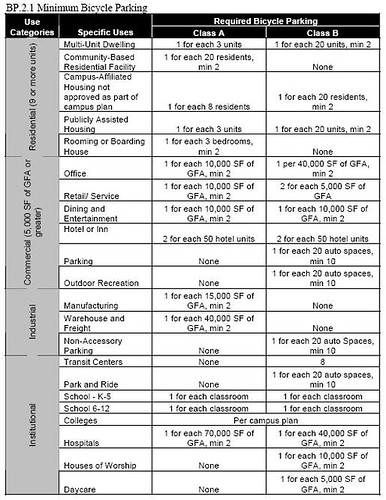
Bicycle parking requirements, DC Zoning Code. Image from Washcycle.
DC Government agency-specific policies
• DC Government agencies should designate a TDM coordinator, and work to implement TDM plans, including the accommodation of bicyclists as part of complete TDM planning.
• Make some parking enforcement officer positions bicycle-based. (This is suggested, but less specifically in the BMP.) (At least one DDOT infrastructure inspector performed his rounds on bicycle.)
• DC Government agencies should provide bike fleets for trips during the workday, when such trips can be reasonably accommodated by bicycle. (Two bikes are available at
• Examples from other cities: (1)
• Are there any DPR recreation centers placed in areas where they could be used as bicycle-shower locations. E.g., the
• Create a payroll deduction programs to assist workers in buying bicycles. (Apparently
• Work with insurance companies to allow for insurance deductions for people who take a confident city cycling class similar to the one for those who take a defensive driving course. This is valuable even if they never bike. And work with the legal side of things to allow people to avoid points on their license if they take the course. (Office of Personnel, DMV, MPD). Use this as a test bed and work to migrate such policies to the private sector.
• Annual bicycle expo (WABA does some of this). Make it into two or three parts (or four, see next point). One portion of the day focuses on bicycle expo for DC Government agencies and employees and the other on businesses (on Friday), from a TDM and mode shift portion. The third portion of the conference (on Saturday) for everybody else, focusing on bicycling and bicyclists. Bicycling exhibit hall on both days. Targeted content according to the audience (
• DDOT already pays for bicycling/pedestrian related professional development training for staff. Expand this program. A bicycle expo could be three days, with the first day dedicated to professional development for DC Government staff (i.e, presentations by Michael Ronkin, John Pucher, Anne Lusk, people from organizations like Toole Design, Alta, etc.), not just within DDOT, but across the agencies (DCOP, DOH, DPR, MPD, etc.) This portion of the “Bike Expo” could be opened up to counterparts in other agencies in the region.
Communications
• Like most DC Government websites, the DDOT website is not oriented to provide differential types of information and service, depending on the needs of various sub-audiences. GoDCGo is a small step forward.
• By comparison, the San Francisco MTA and Transport for London websites organize the delivery of information via mode and provide more and better organized information besides, weaving together both policy information as well as practical information to support bicycling. (Also see
• Develop a coordinated program with WMATA to be able to utilize subway stations as a location to deliver information about bicycling.
• Add an online bicycle trip planner (
• The DC bicycle map list bicycle shops. They should also list gas stations that have air compressors, the location of other air compressors, secured bicycle parking, etc.. Produce maps in smaller runs, printed more frequently, to maintain accuracy.
• Bicycle maps should be produced in a similar fashion to the bus shelter bus maps. They should be mounted in bus shelters and in subway stations. (Metropolitan Branch sign and map on
• List bicycle tours online, produce maps/guides (like the Cultural
• Work with tourism organizations to deliver bicycling maps and tour information. (Work with them before creating the products.)
• Computer-based kiosks for DDOT/TDM/Mode information dissemination in public buildings (City Hall, Reeves Center, Union Station, MLK Library, other regional library branches, National Airport, in visitor centers, Smithsonian Visitor Center, University student unions, etc.)
• Develop other kiosk type transportation information delivery systems based on the
•Within the bikestation concept, create “Mobility Stores” designed to promote mode shift (along the Commuter Store model). Have at least one of these “stores” present Downtown. Fund the development of this concept with the TEA grant.
• Bike Tour/Bike Racing in the city as promotional venture? (Manayunk) (See business development section below)
• Use billboard system provided by Clear Channel contract to promote bicycling. (This is already being done.)
• Make sure that information is available in languages other than English.
Education, capacity building, encouragement, and fitness
• Some European countries require that bicycle training be provided to all children by the end of 4th grade. Institute a similar program in DC, for all schools, public and private.
•Provide age-peer appropriate “refresher” training in middle school and high school. Partners: WABA; DPR. (This will also catch students who move into the city after fourth grade.)
• Annual BikeDC ride (like BikeArlington). Also have annual neighborhood and ward rides. Should start this at the neighborhood level.
• Financial support for bicycle support organizations such as WABA and the Sierra Club. (Some of this is being done, on a contract basis, with WABA.) Federal Historic Preservation Funds are directed by the DC Office of Planning in part to enhancing the capacity of the DC Presevation League by funding enhanced communications programs. Another example is from Louisiana and the Preservation Resource Center of New Orleans, which with the support of the State Historic Preservation Office, is able to publish an excellent newsletter that is more on the scale of a monthly magazine comparable but smaller than the Hill Rag.
• Fund technical assistance and capacity enhancement development for WABA (if needed) to support the realization of an enhanced BMP.
• Work with DOH, DPR, others to promote bicycling as a means for fitness, to address obesity.
• Frequent guided bicycle tours. Bikestations, subway stations, recreation centers, neighborhood libraries, Historical Society as staging locations.
• Work with schools, recreation centers (DPR, Boys and Girls Club) to provide bicycles to people of limited means (BikeTown).
• Bicycle co-ops and other nonprofit bicycling ventures should be financially supported by DDOT bicycling programs. E.g., the now ceased Shaw Eco-Village Chain Reaction project should have received financial support. Bicycle maintenance training programs within DPR, schools, etc. There is a bicycle co-op in
•Develop list of optimal accessories for urban bicycling, especially for transporting goods. Work to develop an “urban bicycling accessories” kiosk program with bicycle shops and other entities.
•Work with bicycle shops so that they are better positioned to serve everyday bicyclists, in addition to the weekend recreational riders and racers.
• Work with supermarkets, Eastern Market (etc.) to provide bikesharing/rental of delivery capable bicycles to their customers (in addition to shared delivery services). Perhaps this can be accommodated within the bicycle sharing program, by providing access to different types of vehicles (just like Zipcar offers access to a different types of vehicles designed to meet differing needs, such as a pickup truck).
• Where appropriate, work with businesses to support the use of bicycle-based delivery vehicles rather than cars.
• Develop specific coordinated MOUs with DPR, DCPS, MPD, and DOH to cover coordinated efforts on bicycling matters.
• Annual Bicycle Expo as discussed above.
• Work with employers and institutions to participate in the Bicycle Benefits program, which provides incentives and rewards to cyclists participating in commuting programs.
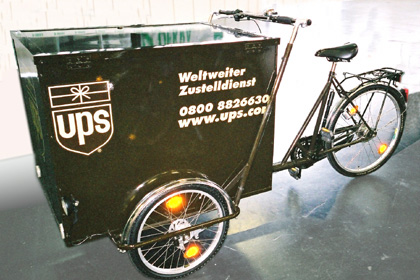
UPS delivery bike, Germany. Photo: WorkCycles.
Enforcement
• In the BMP this should be separated out from Education.
• Theft prevention is not adequately addressed in the BMP. Use the TEA grant to develop and fund a pilot program with MPD, with dedicated officers, to address bicycle theft.
• Launch a bicycle bait system (like LoJack) to reduce bicycle theft.
Bicycle Sharing
• Consider need to cross borders (
• Deal with the regional issue, including WMATA.
• Add more locations (TEA grant?)
• Work to better accommodate tourist needs
• Can institutional memberships be incorporated into the system, in order to give the organizations “bike fleet” capabilities, without having to create and maintain such systems independently?
• Colleges and universities should participate as well, on an institutional membership basis.
• Can different types of non-Velib style bicycles be added to the system, in order to accommodate different trip needs? The addition of these types of bicycles could be funded by the TEA grant.
• Assist the strengthening and development of bicycle shops and rental programs as a business development operation (Partners: DOES, Dept. of Small and Local Business Development) with technical assistance and funding. (E.g., cities like
• Support the creation of a Workcycles franchise (including manufacturing) within DC. (The UPS bicycle delivery vehicle above is a Workcycle.
• Develop list of optimal accessories for urban bicycling. Work to develop a “urban bicycling accessories” kiosk program with bicycle shops and other entities.
• Work with at least two hardware stores with equipment rental and/or bicycle operations (i.e., Fragers, Logan Hardware, Tenleytown Hardware, District Hardware, Brookland Hardware) to assist their acquisition of bicycle trailers (i.e., http://www.bikesatwork.com/) to be made available to customers on a rental basis. (This could also be done with WABA and any extant bicycle co-ops, and access to trailers for rental could be a benefit of membership.)
• Create a bicycle racing facility/Velodrome? (
• Bike Tour/Bike Racing in the city as an economic development and promotional venture? (Manayunk)
• Regarding tourism and recreation objectives, consider the creation of bicycling-oriented “scenic byways” with appropriate signage programs.
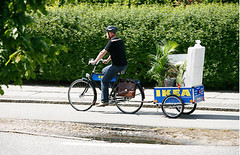
Ikea bike and trailer, provided by Velorbis.
Inter-jurisdictional coordination
• County (Montgomery, Prince George’s, Arlington, Fairfax) and City (Alexandria, DC, others) pedestrian and bicycling coordinators and staff should meet at least twice/year, along with the proposed WMATA counterpart, advocacy groups, and others, to coordinate projects, communicate best practices, etc. Apparently,
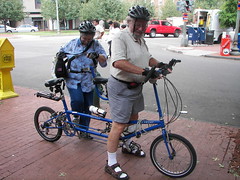
A couple summers ago, I talked to this couple one day seeing them get on their bicycle at the Capitol Hill Starbucks, after finishing coffee on the patio. He retired and biked everywhere. After awhile he realized his wife wasn’t participating and so they bought a tandem, and began bicycling together. They ride all over, including to the YWCA (which has a deep pool) downtown, and to Trader Joes. They live by the Potomac Avenue Metro.
Labels: bicycling, transportation planning, urban design/placemaking



0 Comments:
Post a Comment
<< Home